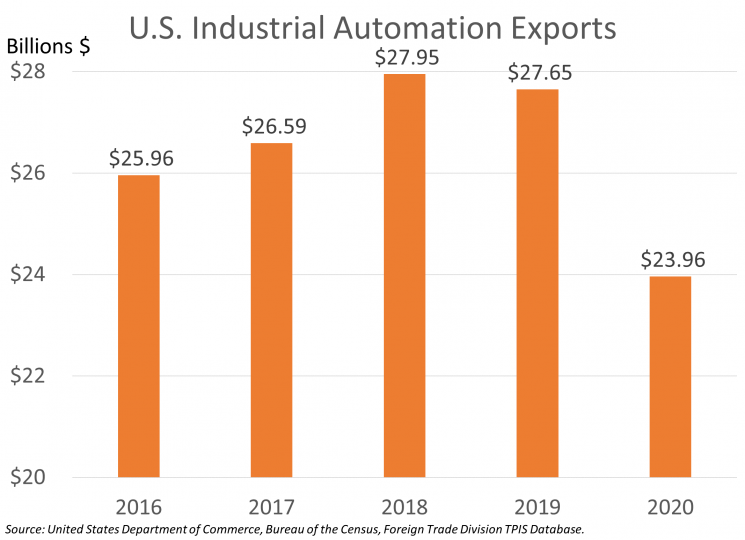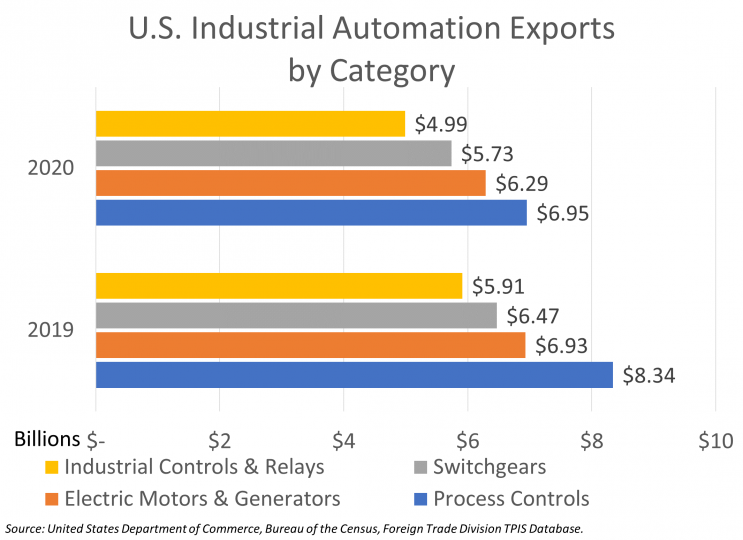Industrial Automation Equipment Snapshot
Industrial Automation Equipment: An Industry Snapshot
With nearly $24 billion worth of exported equipment in 2020, the United States is a competitive supplier of high-end automation equipment to markets across the world and is among the top three largest global exporters along with China and Germany. The Covid-19 pandemic has impacted the productivity of the global industrial automation industry. U.S. exports of industrial automation equipment declined 13 percent in 2020 compared with 2019, but the industry is recovering and is forecasted to increase exports in 2021.
Industrial automation equipment is defined as the hardware and components used to automate factory floors across a wide variety of sectors. This equipment provides manufacturers the bedrock for developing efficient and cutting-edge production systems.
The Equipment
Essential in enabling automated environments, industrial automation products provide the technology that monitors and controls the production and delivery of products across a variety of manufacturing settings. The International Trade Administration breaks down equipment into four main categories:
- Industrial Controls & Relays: Including electro-mechanical relays, solid state relays, motor control relays, as well as motor control centers, programmable logic controllers, and more.
- Switchgears & Switchboard Apparatus: Including control panels, circuit breakers, power switching equipment, regulators, panels, and more.
- Electric Motors & Generators: Including alternating and direct current motors, servos, electrical, hydraulic, and pneumatic actuators, and more.
- Process Controls: For monitoring and controlling process variables, including temperature, pressure, viscosity, voltage current, and more.
Industrial Automation Top Markets
- Mexico – The United States’ largest export market of industrial automation equipment. Both Mexico’s proximity and open market policies make it an ideal trading partner.
- Canada – Close proximity and cultural similarities make Canada the second-largest U.S. export market. Prior to the impact of Covid-19, exports to Canada were growing faster than exports to other markets.
- Germany – A top competitor and partner in terms of quality and technology, Germany is considered the “key” to trading within the European Union.
- Korea – Despite the global pandemic, exports to Korea increased in 2020, making this market the 5th largest export destination.
Know Your Market
Depending on where in the world a U.S. company wishes to export, any number of unanticipated obstacles in foreign markets can greatly impede access, no matter how good the product. Some examples include:
- Content Localization – Often used to ensure that a certain percentage of a finished product is sourced domestically. Brazil, for example, gives tax reductions on many industrial ICT equipment under its Processo Productivo Basico (PPB) initiative, creating barriers for otherwise competitive U.S. companies.
- Technical Barriers – Many governments incorporate regionally developed standards into their import regulations, which frequently become mandatory for their respective markets. As a result, they become barriers to imports from otherwise qualified suppliers. It is important for exporters to verify that their products do not conflict with regional standards.
- Export Controls – The United States Government restricts the exports of certain products and technologies to specific countries or entities to protect U.S. national security interests. Applicable licensing requirements for U.S. products are located in the Commerce Control List (CCL) of the Export Administration Regulations (EAR).
To access the data for the charts in this report, and for additional industrial automation statistics, please click here.
ITA Resources
Amanda Lawrence
International Trade Specialist for Industrial Automation Equipment
Amanda.Lawrence@trade.gov
(202) 322-9146






